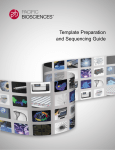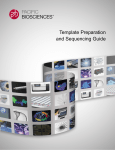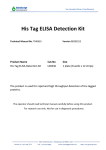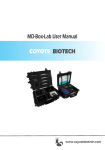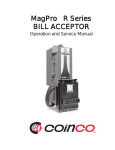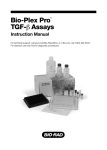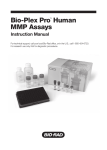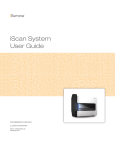Download Release Notes - Bio-Rad
Transcript
Release Notes Bio-Plex Manager™ Software, Version 5.0 October 18, 2007 This document has the following sections: 1. About Bio-Plex Manager™ 5.0 2. Resources for New Users 3. System Requirements 4. Bio-Plex Manager™ Upgrade Kits 5. Standard vs. Security Edition 6. Workstation License 7. Desktop License 8. Network License 9. Reporting Software Problems and Feature Requests to Bio-Rad Laboratories 10. Technical Support 11. Expanding Line of Assays Available 12. Information for Luminex Users 13. Frequently Asked Questions 1. About Bio-Plex Manager™ 5.0 Bio-Plex Manager™ is a major revision that contains new graphing functionality, an updated LXR library, and many other improvements. • New graphing function compares results between samples and/or across analytes. • Updated LXR library ensures compatibility with new Luminex system and xPONENT software • Newly designed fluid reservoir and software support for running unattended “pre” or “post” run maintenance operations. • New Report Table layout for viewing Multiple Analyte sample data across analytes within a single view. • New Data Normalization uses internal or external controls to support gene expression analysis. • Users no longer need to calibrate differently for high-sensitivity assays. The new “Run at High RP1 Target” setting in the Run Protocol process now provides that functionality. • New statistics columns (%CV, Std Dev, and Std Err) for Obs. Conc, Norm Ratio, and Norm FI calculations • Automatic selection of DD gate and beadmap settings, through a new analyte panel assay-type attribute (Standard, MagPro, Luminex MagBeads) to greatly reduce user setup errors. • New setting in Standard Curve view allows outliers to be flagged. • Many new Bio-Rad assay panels available through http://www.bio-rad.com/bio-plex/x-plex. 2. Resources for New Users The CD contains an autorun utility to install the software, database and Microsoft.NET environment. It also configures and starts a Windows service which enables automatic communication with the instrument when you open Bio-Plex Manager™. Refer to the User Guide on the CD for other installation information. The following documentation is available on the Bio-Plex Manager™ 5.0 CD. The documents are stored as .pdf files that can be viewed with Adobe Acrobat Reader. (To download the Reader for free, go to the Adobe Web site at www.Adobe.com.) 10010706 Page 1 of 6 • • • Bio-Plex Manager User Guide (10010751) Bio-Plex Manager Security Edition Configuration Setup Guide (10000528, Rev C) Hardware Protection Key Utilities (to configure multiple network licenses) Online help is available from the application toolbar. Many other Bio-Plex Manager™ resources are available at the Bio-Rad Laboratories website: http://www.bio-rad.com/bio-plex. 3. System Requirements Component Operating system Minimum Recommended Processor Windows 2000 or XP Note: Workstation version of Bio-Plex ManagerTM requires Windows XP Pentium IV or equivalent, 2.8 GHz Windows XP Professional Hard disk space System memory Screen resolution Screen colors Ports for connecting instrument (required for Workstation license only) Port for connecting the HASP key Other software 40 GB 512 MB 1024 × 768 256 colors 1 RS232 serial port and 1 USB port 1 USB port Internet Explorer 6.0 or later Pentium IV or higher, 2.8 GHz or higher 80 GB 1024 MB 1280 × 1024 24-bit True Color 1 RS232 serial port and 1 USB port 1 USB port Internet Explorer 6.0 or later Microsoft Excel 2000 or later Microsoft Excel 2000 or later 4. Upgrade Kits Upgrade kits are available which contain everything needed to upgrade previous Bio-Plex Manager™ versions, including instructions. See the table below for the Upgrade Kit part numbers. If you are upgrading from . . . Bio-Plex Manager 4.1 or 4.1.1 Bio-Plex Manager 4.0 Bio-Plex Manager 3.0 Bio-Plex Manager Standard for IS 2.3 Order Upgrade Kit Part # 171SUPG41 171SUPG40 171SUPG30 171STND23 5. Standard vs. Security Edition The Standard Edition gives all users equal access to all features of the software with no restrictions and no electronic audit trail. Bio-Plex Manager™ 5.0 Security Edition provides a secure environment for the maintenance, verification, and tracking of all electronic records generated by Bio-Plex Manager™. These records include Protocol and Results files, the Calibration, Validation, and Instrument Operation Logs, and the Audit Trail. Bio-Plex Manager™ 5.0 Security Edition software enables compliance with FDA 21 CFR Part 11 regulations. The Security Edition is controlled by a specially-coded hardware protection key. When the Security Mode is enabled, only an authenticated user can access the software. Each user is assigned to one of six user levels. Each level gives the user access to specific features and functions of the software. A table listing the functions accessible at each user level is provided in the User Manual, on the CD included with BioPlex Manager™ 5.0. 10010706 Page 2 of 6 6. Workstation License Bio-Plex Manager™ Workstation is designed to collect, analyze and output data from the Bio-Plex® system. It runs as a Windows application on a PC that is directly connected to the array reader and microplate platform. You must run Windows XP to have full function using this license. 7. Desktop License The Desktop license enables the user to analyze data files, but not control the array reader and platform. Instrument communication and control functions are not available with this license. You can run this license on either Windows XP or Windows 2000. 8. Network License The Network license allows multiple Windows XP or 2000 users to run Desktop licenses over a computer network. Like the Desktop license, it enables users to analyze data files, but not control the array reader and platform. 9. Reporting Software Problems and Feature Requests to Bio-Rad Laboratories The installer for Bio-Plex Manager™ also installs Solobug (BPM) in a Bug Reporter subfolder within your Bio-Plex Manager™ folder. Please use this program to request features, request design changes, or report non-critical Bio-Plex Manager™ problems. To use Solobug, click on the Windows Start button, select the Bio-Plex Manager™ folder from the Programs list, and open Solobug from within this folder. Enter the required information with a description of the request and select Save. This creates a report for attaching to an email to Bio-Rad. Please email Solobug files to [email protected] from within the U.S., and [email protected] from outside the U.S. 10. Technical Support Bio-Rad Technical Support in the United States is open Monday–Friday, 6:00 a.m. to 5:00 p.m., Pacific Standard Time. Worldwide technical support is available on the Web at http://www.consult.bio-rad.com. Phone: (800) 424-6723, option 2, option 3 (510) 741-6910, option 2, option 3 Fax: (510) 741-5802 E-mail: [email protected] (U.S.) [email protected] (International) 11. Expanding Line of Assays Available Bio-Plex assays are multiplex bead-based assays based on xMAP technology and optimized for the BioPlex® suspension array system. Bio-Rad Laboratories offers an expanding line of assays and reagent kits, including: • Cytokine assays • High-sensitivity cytokine assays • Phosphoprotein assays • Total target assays • Amine coupling kit • xMAP COOH beads 10010706 Page 3 of 6 Ordering information and catalog numbers for x-Plex assays in one or ten 96-well plate formats are available at www.bio-rad.com/bio-plex/x-plex. 12. Installation Instructions for Luminex Users Bio-Plex Manager™ 5.0 is compatible with Luminex xPONENT software. Because the Luminex LXR library has been updated with this version, older Luminex software will not function once you upgrade to Bio-Plex Manager™ 5.0. In order to run both Luminex and Bio-Plex Manager™ on the same machine, you must upgrade your Luminex IS 2.3 software to the current Luminex software. 13. Frequently-Asked Questions What operating systems does Bio-Plex Manager 5.0 require? The Network and Desktop licenses run under Windows XP or 2000. The Workstation license requires Windows XP to have full function. Will BPM 5.0 run on my Luminex xPONENT system? Yes. BPM 5.0 runs with the same firmware and library as the Luminex xPONENT system. Will BPM 5.0 run on my Luminex IS 2.3 system? No. BPM 5.0 runs with different firmware and library than the Luminex IS 2.3 system. The two applications cannot be run on the same instrument. Does BPM 5.0 offer the Security Edition? Yes. All of the features that were included in BPM 4.1.1 are still present in 5.0. Additionally, the ability to overwrite files until they are signed has been added. Is my Bio-Plex system upgradeable to BPM 5.0? If your reader is running BPM 4.1.1, it is fully upgradeable to BPM 5.0. If you are running BPM 4.0 or earlier and your reader was purchased prior to October 2000, it cannot be upgraded to 5.0. If your platform was purchased prior to August 2001, it may not be upgradeable. I am trying to upgrade to BPM 5.0, but the LxFirmware wizard isn’t detecting all of the firmware versions. What’s wrong? The firmware wizard will only upgrade or downgrade the firmware when using the serial cables. Be sure you have not prematurely connected the USB cable. If the problem is detecting the HTF firmware, be sure you are using the correct cable. You must reconnect the platform serial cable to the HTF. Be sure you are not using the CAN BUS cable that is supplied to connect the reader to the HTF. I upgraded to BPM 5.0 and installed the new USB cable, and now the system will not connect. What’s wrong? This could take a couple of minutes due to the automatic port detection feature. If you still cannot connect after at least 3 minutes go to the Device Manager in the Control Panel and see if there is a menu item listed for “Luminex Devices”. If not, go to ‘Actions’ and select scan for new hardware, to see if the “Luminex Devices” item is created. If so, try to connect again. If you still cannot connect, replace the USB cable with the serial cable that was previously installed. Try connecting. If the system connects, you can run the system with the serial cable until field service can be notified. I want to reinstall the previous version of BPM to do my work, because I made an unsuccessful attempt to upgrade to BPM 5.0. I get “Error 1722” when I begin the installation. What do I do? 10010706 Page 4 of 6 Remove the hasp key and do the install again, but use the “Custom” installation method, and do not install the “Hasp Support” portion of the installer. Even though you uninstalled BPM 4.1.1, or other BPM version, the uninstall process does not uninstall the hasp key. The different hasp keys in the two software versions are in conflict. Earlier BPM versions will operate normally using the BPM 5.0 hasp key. I have BPM 5.0 on my system and keep getting a message during my runs stating “the sheath pressure limit was triggered during the acquisition”. Why? The system pressure settings are not correct. Go to the folder ‘Bio-Plex Manager 5.0’ and open the folder ‘Utilities’. Double click on the file RIPS.exe. In the dialog that comes up select ‘Proceed’. Cycle the power on the instrument and launch BPM 5.0. The system settings will be set automatically. Follow the instructions then try running samples again. If the error message continues, you have a leak in the system. I have purchased BPM 5.0 for my system, but also have applications for which I must use xPONENT software. My data is not very good after I switch applications, what gives? Be sure to calibrate any time that you change applications, as calibration settings don’t carry over between the applications. Run only one application at a time. The same error message continually comes up during a run. I know this problem will not hurt my data, but I must baby sit the instrument to keep it running. Can I turn off the message? Yes. If the run is in progress, stop your run and go to the Utilities folder in the Bio-Plex Manager 5.0 folder. Double click the BWMM.exe file (Bio-Plex Warning Message Manager). Click the option to “Hide” the warning messages. Restart your run using Rerun/Recovery mode. The message you were getting will no longer stop the run. But, beware that you have turned off ALL error messages. As soon as your instrument problem is fixed, be sure to return to BWMM.exe and click the “Show” option to re-enable the messages. The status bar on the Desktop shows that LX Service is stopped. How come I am able to launch and run BPM? Windows XP will show that LX Service is stopped whenever more than one user is logged onto the system. Ignore it, this is a windows bug that does not affect the Bio-Plex system. What’s the purpose of Sample Timeout? This allows you to set the acquisition time of the samples you are running to a value less than the default time. Default times are based on sample volume, so for a 50 µl sample volume, the default sample timeout is about 80 seconds. For a 100 µl volume, it is about 150 seconds, etc. There is no reason to allow longer times because the sample will have completely run through the system by the default time. But, shorter times might be used to speed up the run, especially if you are running a plate in which all the wells don’t have the same bead regions present, as might be encountered in some phosphoprotein assay runs. My run is taking a long time on each sample because I neglected to add one of my beads. Can I set Sample Timeout in the middle of a run, and is it tracked? Yes. You can stop a run and set or change the Sample Timeout time and restart the run using Rerun/Recovery. The Sample Timeout time is tracked in the raw data table for each sample. When would I use a 25-region map instead of the 100-region map? The regions in the 25-region map are larger and will provide better classification efficiency if using Bio-Rad’s magnetic beads, which are larger (8 µm) than the non-magnetic beads (5.6 µm). 10010706 Page 5 of 6 Can I change bead region maps during a run and, if I do, will the region used in each sample be identifiable? Yes. You can stop a run and change the bead map, then restart the run using Rerun/Recovery. It will be tracked in the raw data table for each well. Why can’t I calibrate on high RP1 target with BPM 5.0? I always used to calibrate on high RP1 target for my work, and I am concerned that the system will not operate optimally after calibrating on low RP1 target. Although the calibration window only allows entry of the low RP1 target, the CAL2 target value calibrates at low and high automatically. These values are stored in the system, so that if the high RP1 target is required for your run, all that is needed is to check the box to “Run at High RP1 Target” in either the Run Protocol window or in the Validation window. There is no difference from before in the accuracy of the calibration. I must now select the type of assay from Add Panel in the Select Analytes dialog window. How do I know which type of assay I am setting up, if I have developed my own assay from raw beads and my own antibodies? Select the type of assay based on where you obtained your beads. If your beads were obtained from Bio-Rad and are non-magnetic, you select Bio-Plex or if magnetic, Bio-Plex Pro. If your beads were obtained from Luminex or any Luminex partner, select xMap for non-magnetic beads and MagPlex for magnetic beads. By selecting the correct assay type, the software will correctly set the DD gates and bead map for your test. Can my BPM 3.0, 4.0, 4.1 or 4.1.1 files be opened on BPM 5.0? Yes. They can be opened and used. Can BPM 5.0 files be opened on BPM 4.1.1 or earlier versions? No. BPM 5.0-generated files cannot be opened on BPM 4.1.1 or earlier versions. Can I run Luminex MagPlex beads on the Bio-Plex system? Yes. Go to Add Panel in the Select Analytes window of the New Protocol setup dialog, and set up your analytes. Next, click the dropdown menu labeled Assay, and select MagPlex. This will set specific gate settings and bead map for the MagPlex beads. 10010706 Page 6 of 6











